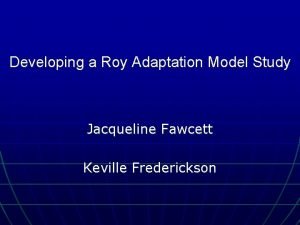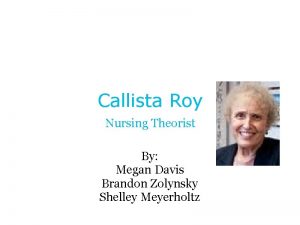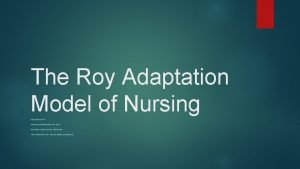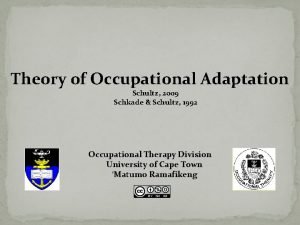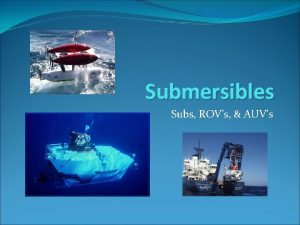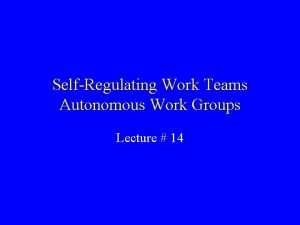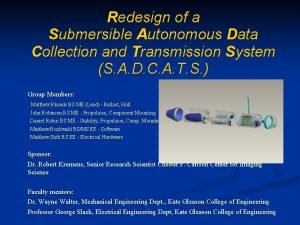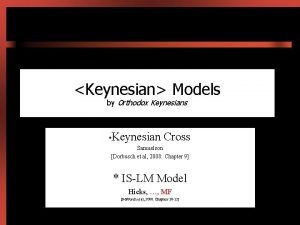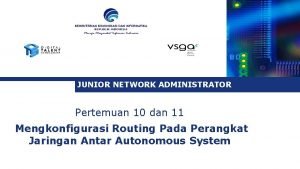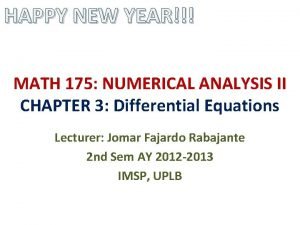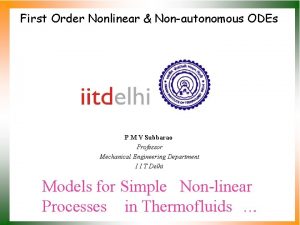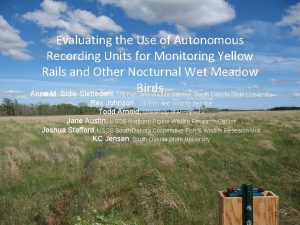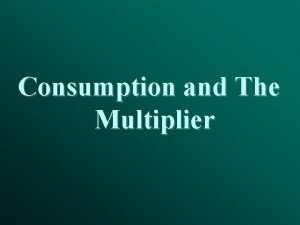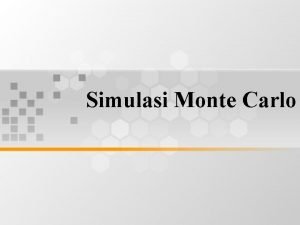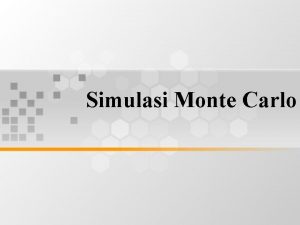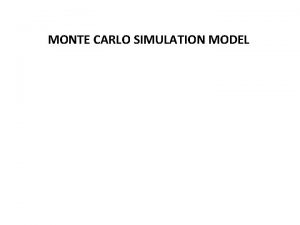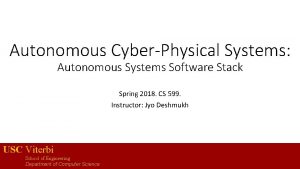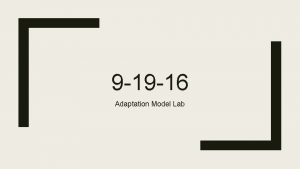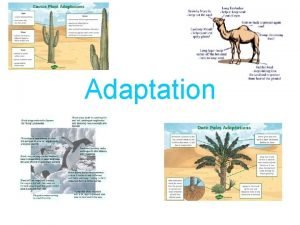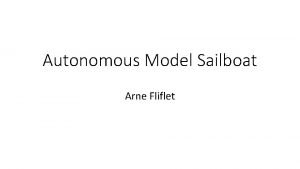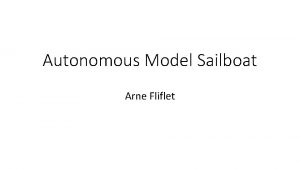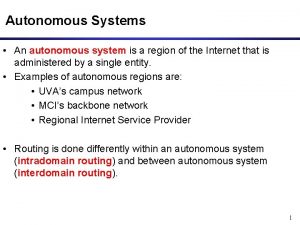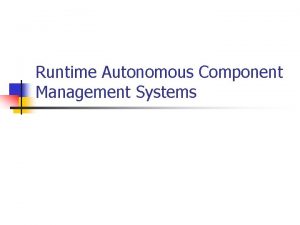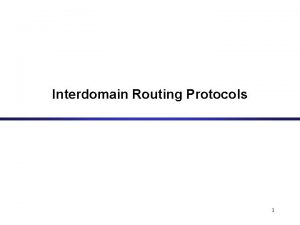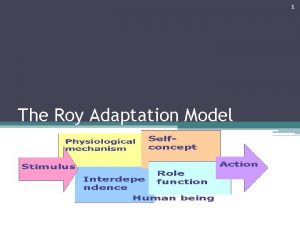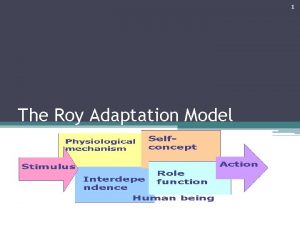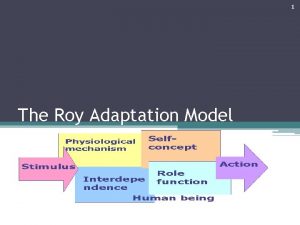Centre for Autonomous Systems Model Adaptation in Monte



















- Slides: 19

Centre for Autonomous Systems Model Adaptation in Monte Carlo Localization Omid Aghazadeh SWAR Sept 8, 2009 © 2009 Omid Aghazadeh

Centre for Autonomous Systems Outline The localization problem & localization methods The Particle Filter Contribution: Model adaptation for Particle Filter Conclusions SWAR Sept 8, 2009 © 2009 Omid Aghazadeh

Centre for Autonomous Systems Localization Problem Determining the pose of the robot relative to a given map of the environment using sensory information → pdf Original Figure from Probabilistic Robotics, Thrun et Al, MIT Press SWAR Sept 8, 2009 © 2009 Omid Aghazadeh

Centre for Autonomous Systems Localization Problem cont'd Varying degrees of uncertainty due to measurement errors, model errors, unknown associations and etc make the localization problem challenging Localization Local(Position Tracking): We know the pose of the robot at the very first step Global: We just turned on the system and need to find where we are SWAR Sept 8, 2009 © 2009 Omid Aghazadeh

Centre for Autonomous Systems Multi modal distributions global localization, (unknown) data association → Multi modal distribution SWAR Sept 8, 2009 © 2009 Omid Aghazadeh

Centre for Autonomous Systems Multi modal distributions, cont’d Multiple observations narrow down the hypothesis space, but does not solve multi modality SWAR Sept 8, 2009 © 2009 Omid Aghazadeh

Centre for Autonomous Systems Localization Methods Bayes Filter + 1 st order Markov assumption: Continuous EKF Localization cannot deal with multi modal distributions Discrete: can deal with multi modality Grid based Accuracy Waste of resources Particle Filters SWAR Sept 8, 2009 © 2009 Omid Aghazadeh

Centre for Autonomous Systems Particle Filter The particle filter’s elegant solution: use samples to represent the pdf Original Figure from Probabilistic Robotics, Thrun et Al, MIT Press SWAR Sept 8, 2009 © 2009 Omid Aghazadeh

Centre for Autonomous Systems Particle Filter, cont’d Re-Sampling Survival of the particles with more weights Prediction Moving particle set using Diffusion →(Process Noise Model) Weighting Likelihood using Sensor Model Very high likelihood for a few particles leads to particle deprivation →(Measurement Noise Model) SWAR Sept 8, 2009 © 2009 Omid Aghazadeh

Centre for Autonomous Systems Problems with the standard particle filter How many samples(particles) to use? → KLD Sampling(Fox 2006) How to define process and measurement noise models? Constant: can be too low (→ divergence) or too high( → loss of accuracy) Adaptive: contribution of this presentation SWAR Sept 8, 2009 © 2009 Omid Aghazadeh

Centre for Autonomous Systems KLD Sampling The number of particles we need depends on how scattered the particles are Quantize the state-space and count the bins which contain at least one particle (k) The optimal number of particles follows a chi squared distribution with k-1 degrees of freedom SWAR Sept 8, 2009 © 2009 Omid Aghazadeh

Centre for Autonomous Systems Model Adaptation When do we need more diffusion? →(Process noise model) When is it better to have sharp likelihood distribution? →(Measurement noise model) SWAR Sept 8, 2009 © 2009 Omid Aghazadeh

Centre for Autonomous Systems Model Adaptation , cont’d We need to have sharper likelihoods if the distribution is compact We need weaker diffusion when the particles are accurately representing the desired distribution Sensor model alteration/adaptation SWAR Sept 8, 2009 © 2009 Omid Aghazadeh

Centre for Autonomous Systems Experiments Standard KLD vs Adaptive KLD in tracking problems(uni-modal). Process and Observation noise models adapted, sensor model altered. SWAR Sept 8, 2009 © 2009 Omid Aghazadeh

Centre for Autonomous Systems Experiments, cont’d Number of particles vs time SWAR Sept 8, 2009 © 2009 Omid Aghazadeh

Centre for Autonomous Systems Experiments, cont’d Scatter of Particles vs time SWAR Sept 8, 2009 © 2009 Omid Aghazadeh

Centre for Autonomous Systems Experiments, cont’d Error vs time SWAR Sept 8, 2009 © 2009 Omid Aghazadeh

Centre for Autonomous Systems Experiments, cont’d Adapted Model Parameters vs time(PWO) SWAR Sept 8, 2009 © 2009 Omid Aghazadeh

Centre for Autonomous Systems Conclusions Model adaptation can improve KLD sampling method in terms of Accuracy(mean of the distribution) Certainty(spread of the distribution) Required resources(memory) Computations(run time) Particle Deprivation(multi hypothesis) SWAR Sept 8, 2009 © 2009 Omid Aghazadeh
 Difference between centre of mass and centre of gravity
Difference between centre of mass and centre of gravity How to find centre of gravity
How to find centre of gravity Roy adaptation model diagram
Roy adaptation model diagram Sister callista roy theory
Sister callista roy theory Callista roy biographie
Callista roy biographie Occupational adaptation theory
Occupational adaptation theory Associative stage
Associative stage Autonomous benthic explorer
Autonomous benthic explorer Autonomous work group
Autonomous work group Autonomous data harvesting
Autonomous data harvesting Atonic vs autonomous bladder
Atonic vs autonomous bladder Zubair
Zubair Equilibrium output
Equilibrium output Autonomous system adalah
Autonomous system adalah Autonomous spending
Autonomous spending New year equation
New year equation Autonomous ode definition
Autonomous ode definition Autonomous recording units
Autonomous recording units Autonomous consumption
Autonomous consumption Explain relative income hypothesis
Explain relative income hypothesis


